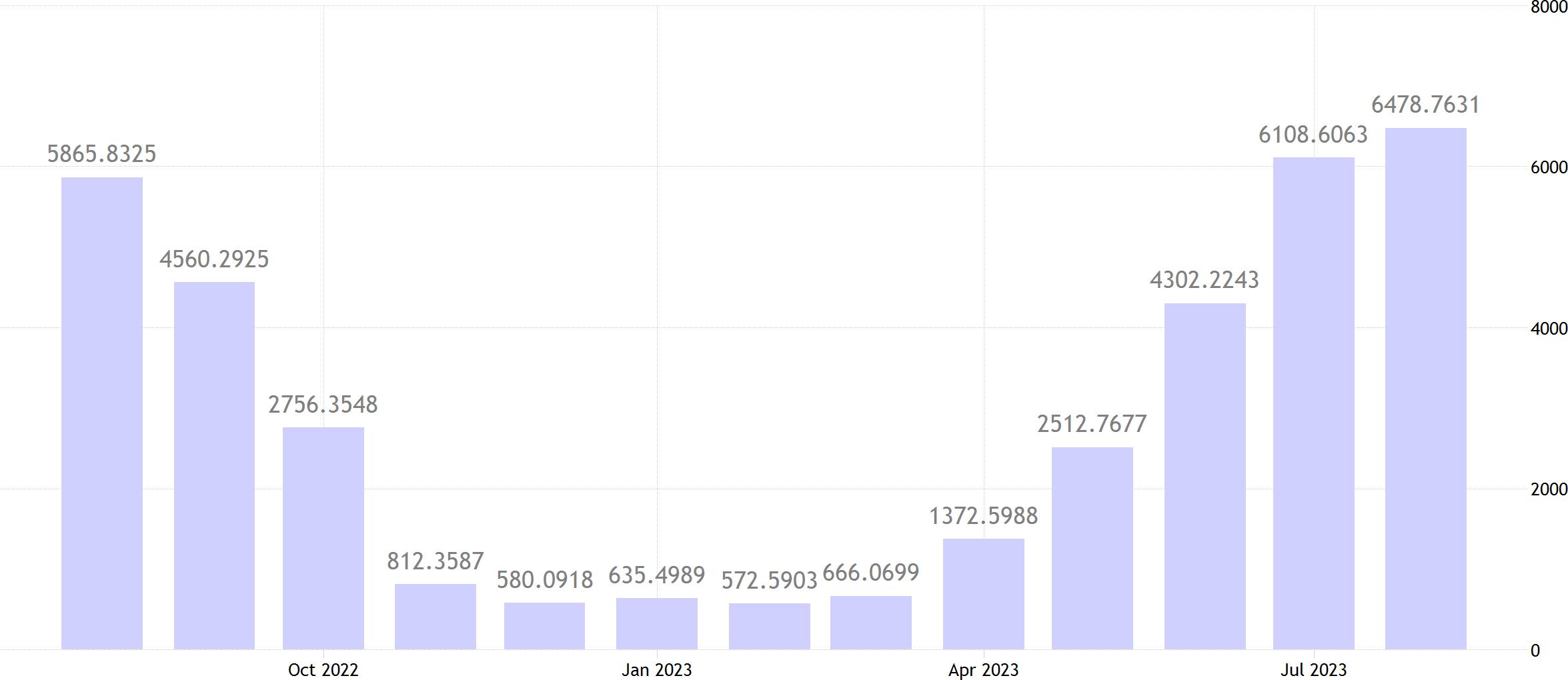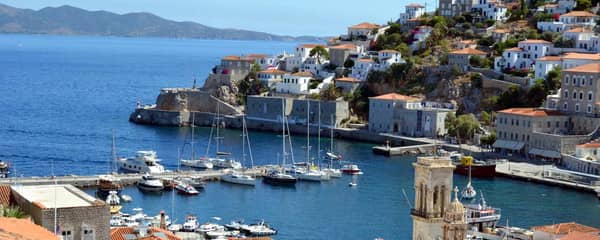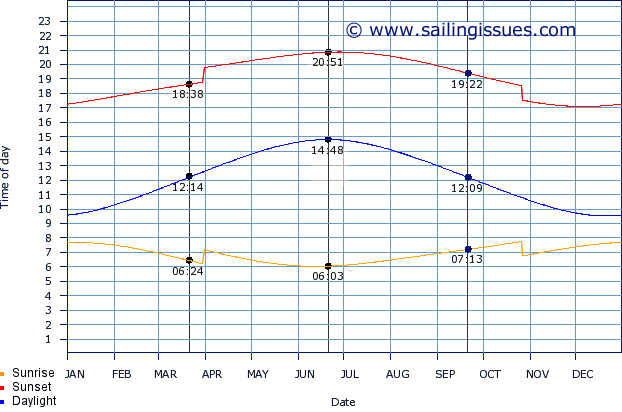When to sail Greece
The yacht charter season in Greece starts late March and ends in November.
The graph below deals with all tourists, not just the sailing tourists. Yet a graph for just yacht charters will no doubt spike even more in the sailing high season, which runs from June till September

Sailing Greece in the high season
When sailing in the high season – July & August + surrounding weeks – you should take into account the following:
- The most crowded sailing areas will be Corfu, Lefkas and the Saronic Gulf.
- You will also find a lot of non-sailing tourists on the popular islands of Mykonos, Ios, Santorini, Kos, Rhodes, etc.
- In the Aegean Sea the strong Meltemi storms can not only be a hindrance but also a hazard to sailors.
- Yacht charters are least affordable in July and especially August.
- All tavernas, museums, archaeological sites, thermae, etc will be open.

Reasons to sail Greece before June
- An abundance of flowers on lush, luxuriant islands due to the spring rains of Februari and March
This particularly concerns the Cyclades and Dodecanese, which will gradually turn dry and barren during the high yacht charter season.
Despite losing some of its freshness and most of the flowers, the Ionian and Northern Aegean islands will remain green and fertile throughout the whole sailing season.
Likewise, the fecund river valleys along the Peloponese and mainland Greece coasts. - Affordable yacht charters: the high – and most expensive – season peaks in August and the surrounding shoulder-season months.
Typically, but give or take a week, the sailing season is broken into the following pricing periods:
A 100% most expensive price
B 85 – 88%
C 70 – 75%
D 56 – 65%
E 43 – 52% very affordable
F 35 – 45% most affordable
Dates refer to Saturdays in 2024Dates refer to Saturdays in 2025 - Fewer charter yachts; even when arriving late in the afternoon there will be ample space in ports and anchorages, yet most tavernas and facilities are already open.
- In the Ionian the Maistro already delivers steady reliable winds much like in the Aegean where there are no Meltemi winds yet.
- Orthodox Easter in 2024 Orthodox Easter Sunday will be on May 5 – while on 31 March for Roman Catholics – which is the biggest church holiday in Greece, traditionally celebrated with sumptuous amounts of wine and the roasting of a quite a lot of lambs. Ascension is 40 days after Easter and Pentecost is 50 days after Easter.
Year Easter Sunday
(Gregorian calendar)Eastern Orthodox Church
(Julian calendar date converted to Gregorian)2024 March 31 May 5 2025 April 20 April 20 2026 April 5 April 12 2027 March 28 May 2 - As is shown in the graph below, daylight hours peak in 21 June – the summer solstice – with 14 hours and 48 minutes.
On 21 September the day is 2 hours and 39 minutes shorter, yet even as early in the sailing season as 21 March the day is longer – albeit by just 5 minutes – than on 21 September.

Sunrise, Sunset and Daylight for Athens Greece; the “spikes” correspond to Daylight Saving Time.
Conclusion: sailing after the main season means a lot less daylight hours compared to sailing before the main season.
There is just one downside to the early season:
The water temperature will reach “pleasant swimmable” levels in mid May (19 – 21 °C) but in early April the sea temperature is usually just 16 – 18 °C, in my view a bit chilly. Fortunately, this rapidly improves to a very pleasant 23 °C 74 °F in the beginning of June. See all seawater temperatures maps per month.
Note, that the actual temperatures in secluded anchor bays and beaches are easily a few degrees higher than out on the open seas. Moreover, due to climate change and subsequent milder winters you can further add 1 or 2 degrees on top of these historical statistics.
Early season conclusions
All this considered, I have found that the optimum timespan to sail Greece is mid April – first week of June.
If snorkeling and swimming is paramount, aim for early May – mid June.
For this reason Gulets and Blue cruises rarely sail before mid April.
Likewise, flotillas & assisted bareboats are offered from mid April.

Reasons to sail Greece in Sept and Oct
- Again fewer yachts and tourists: Especially in the popular areas of the Ionian Sea and around Athens the amount of tourists will drop pleasantly after the first week(s) of September.
- Still steady winds in the Ionian (Maistro wind) and no more Meltemi winds in the Aegean.
- More affordable yacht charters: the high – and most expensive – season usually ends after the first week of September (some charter companies a week earlier or later). And with the start of October a further decrease.
- Seawater with tropical temperatures, ideal for swimming at beaches, snorkeling at anchorages and diving: 28 – 30 °C 83 – 87 °F.
Again only one downside:
Typically the Cyclades can suffer from shortages of fresh water: except for Naxos none of the cycladic and dodecanese islands have perennial rivers and are therefore already rather barren, dry and parched in the yacht charter high season, let alone after…
Also, for (charter) yachts it will be more difficult and expensive here to maintain full water tank levels. Propitiously, the Northern Sporades and the Ionian islands will stay green and fertile all year round, but are even more beautiful in springtime when covered in colourful flowers.
If sailing in April-May-June is not possible, the next best period is in second half of September, especially in the Cyclades or Dodecanese, since the temperatures are more than a few degrees higher than Corfu • north Ionian or Athens • Saronic. More on sea surface temperatures…
Climate change
After a series of anomalous winters there are four major influences on the yacht charter season:
- Season starts increasingly earlier and is creeping towards the beginning of March.
- Already agreeable swimming temperatures earlier in May, especially in the south-east Aegean.
- Less rain → Cyclades are becoming even more dry.
- Slight but significant increase of storms, windless periods, heat waves and forest fires.
Also see the IPCC 5th Assessment on climate change.
The Mediterranean basin is a global heating hotspot: while the world is now about 1.1°C warmer than it was in the 1970s, the Med is already up 1.5°C and on course for 3° – 5°C by the end of the century. Making matters far worse: usually warmer will also mean wetter, yet not in the Med, where rainfall is set to plunge by between 10% and 60%. Finally, read this explainer on Greek forest fires.
A persistent marine heatwave in the Mediterranean raises the water temperatures an alarming 4°C to 5°C above the 1991 to 2020 average.
June and September are popular
Interesting insight : yachtspersons who plan ahead tend to sail in June and September! For these months and surrounding weeks you will need to start looking more than 8 months in advance to secure a reliable top charter yacht or catamaran.
Winter sailing
Most yachts will be hauled out of the water after mid-November, but sailing in the winter in Greece is certainly possible, and the weeks after Christmas are actually in vogue.
Note that there is less technical support on the islands.
Read more articles in my yachting guide.
Yachting guide
- Charter guide
- Assisted bareboats
- Bareboat requirements
- Choosing a charter yacht
- Catamarans & monohulls
- Prevent seasickness
- Greek sailing areas
- When to sail in Greece
- Yacht charter provisioning
- Itineraries Ionian
- Itineraries Argo-Saronic
- Itineraries Cyclades
- Itineraries Dodecanese
- One-way itineraries
- Flights & ferries
- Last minutes & budget
- Sailing between Greece & Turkey
- Greek chart terms
- Greek fishing techniques
- Climate graphs Athens
- Climate graphs Bodrum
- Distances sailing Greece
- Itineraries Ionian + Aegean